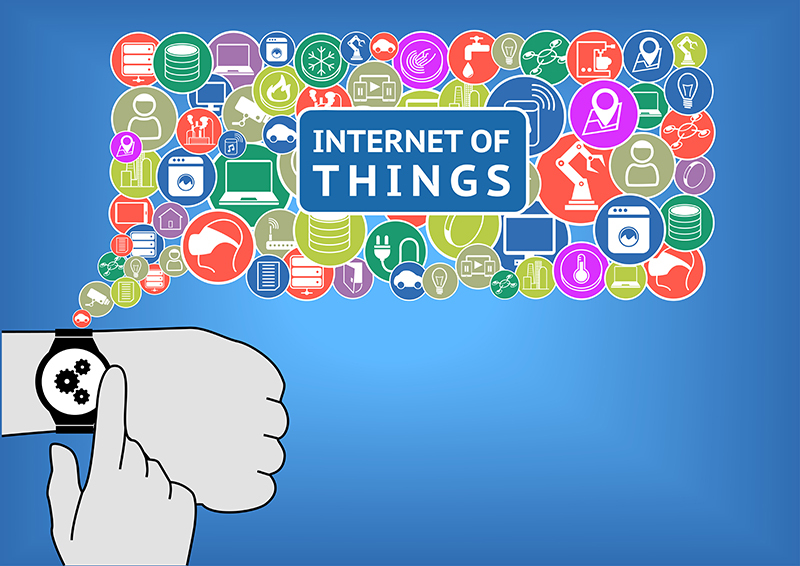
In 2015, the International Data Corporation estimates that more than 45 million wearable tech gadgets will be distributed globally. Although that number reaches less than 1 percent of the world’s population, wearable technologies are situated to increasingly impact lives and industries as mobile leaders push digital boundaries.
One unique opportunity will be the integration of wearable technology into the Internet of Things (IoT). IoT is creating a more efficient digital ecosystem by augmenting how devices interact when connected. As a conduit for technological progression, wearable tech gadgets are a natural addition to this ecosystem. Even walking through just one day in a thought exercise, the opportunities for integration are abundant.
7 a.m.
You wake up for work as your favorite morning playlist gradually increases in volume from your connected speaker. Walking around your apartment, lights automatically turn on as your smartwatch indicates your changing location to your house’s electrical system. Your quick yoga work-out is captured on your smartwatch. After sensing that you’ve entered the bathroom, your smartwatch signals for your playlist to switch to the bathroom speaker. Music streams in as you rinse and repeat.
8:30 a.m.
During your morning commute you admire all of the beautiful spring flowers, until you suddenly start to suffer from an asthma attack -- pollen! Recognizing the physical indicators of the asthma attack, your smartwatch triggers your car’s safe-driving features. Your car slows, pulls itself to the side of the road and avoids what could have been a disastrous accident. After you use your inhaler, and monitor your own wellness on your smartwatch, you safely finish your drive to work.
12 p.m.
Taking into account your morning workout and your asthma concern, your smartwatch indicates to your connected mug that you need to be drinking more water. Your mug flashes a reminder for a refill, so you have a healthy serving of water with your lunch.
1 p.m.
Having made it safely to work, you complete afternoon rounds of your hospital patients. In room 205, a man’s insulin drip switches on as his health-hoop monitors abnormally low levels. In room 218, you expedite treatment by using your smart glasses to perform a bedside x-ray on a woman’s arm.
5:15 p.m.
Driving home from your shift, you pass the neighborhood Kroger. Using geolocation technologies, your smartwatch senses the store and then checks with your refrigerator to see if you’re low on any groceries. You stop and purchase a much-needed gallon of milk.
6:30 p.m.
While grabbing dinner with friends, you take turns discussing your days. The first friend explains how productivity at their manufacturing facility is up 10 percent because smartwatches are now more productively activating assembly line machines based on an employee’s proximity to them. The second friend describes how they were able to control dressing room conveniences from around the store while shopping at their favorite boutique. The third friend does not yet own any wearable tech gadgets and feels left out of the exciting conversation.
10 p.m.
Snuggling into bed with a classic Ayn Rand novel on your tablet, a cool breeze creeps through the room’s old windows. Assessing your body’s temperature, your smartwatch compares those readings to your predetermined preferences and systematically turns up your apartment’s heat. You fall asleep, comfortable and satisfied by your digitally-driven day.
Though it might sound extremely futuristic, a day like this is entirely possible today, and becoming a common day is a near-term reality. As the IoT grows, so will the opportunities for wearable technology to change how users interact with the world around them. These gadgets will improve upon contextualized user preferences, linking intelligence across devices to streamline a user’s experience.
From home to work, wearable technologies will find the greatest value in their connection to other devices. The self-actualization of these devices will dramatically improve our lives, especially in the ever-evolving digital ecosystem. If Apple’s newest software update -- which automatically downloads an undeletable Apple Watch app -- is of any indication, industry leaders anticipate the growth and permanence of wearable tech gadgets to be vast.
And if you can’t delete them, join them.
Photo Credit: a-image /Shutterstock
 Stephanie helps to drive vision and bring operational excellence as Chief Operations Officer for PointSource. She manages the design, delivery, and marketing organizations, creating intuitive experiences built on cutting edge technology, while crafting Agile and efficient collaboration patterns. Stephanie is rapidly identifying ways mobility revolutionizes how people live and work across a variety of industries and builds successful mobile strategies in collaboration with clients.
Stephanie helps to drive vision and bring operational excellence as Chief Operations Officer for PointSource. She manages the design, delivery, and marketing organizations, creating intuitive experiences built on cutting edge technology, while crafting Agile and efficient collaboration patterns. Stephanie is rapidly identifying ways mobility revolutionizes how people live and work across a variety of industries and builds successful mobile strategies in collaboration with clients.

